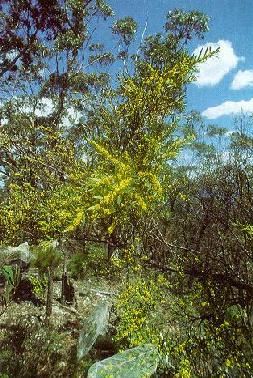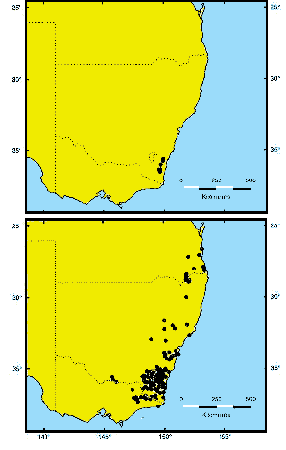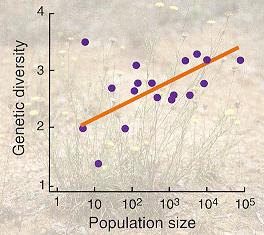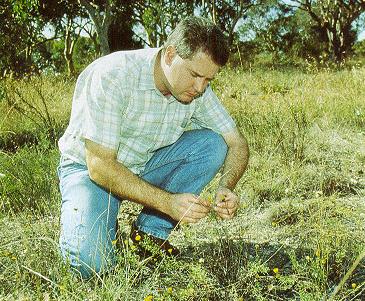In an effort to conserve Australia's rare and threatened plants, CPBR scientists are working towards identifying the genetic differences between rare and common species. The scientists are also working to assess genetic and ecological impacts of habitat fragmentation.
Variation in Naturally Rare Plants
Scientists are comparing the levels of genetic variation within rare species, to those of closely related common species. This research will identify any consistent differences in the amount and distribution of genetic diversity in rare plants - information that will provide guidelines for rare plant management and conservation.
In comparing species such as the rare Daviesia suaveolens and common D. mimosoides (the bitter pea) scientists have discovered that their genetic makeup is quite different. Populations of the rare species are three times more genetically different from each other than those of the common plant.
|
Isolated patches of Daviesia suaveolens tend to be genetically unique. |

|
One explanation for this is the different geographic distributions of the species. While populations of the common species are virtually continuous, allowing plants to comprise one gene pool, rare species populations are more isolated, limiting gene "movement".

|
The rare bitter pea Daviesia suaveolens (top) has a restricted distribution while its close relative D. mimosoides (bottom) is more widespread. |
Scientists are also studying plants that were once widespread and common, but which are now rare due to clearing woodlands and grasslands for agriculture.
A study of remaining populations of the threatened grassland daisy the Button Wrinklewort (Rutidosis leptorrhynchoides) has shown that as population size decreases genetic diversity is lost and inbreeding increases due to increased self-pollination.
|
"Genetic erosion" occurs in small populations of the Button Wrinklewort (Rutidosis leptorrhynchoides). |

|
In the long-term, a loss of genetic variation (sometimes referred to as "genetic erosion") will leave species with few evolutionary options in the face of changing environmental pressures.
In the short-term, increased inbreeding can dramatically affect the chance of the plants' survival. Inbreeding results in offspring that are not as fit as their parents, producing plants that do not grow as quickly, set as many flowers, or have as many seeds.
Scientists are currently monitoring both large outbred and small inbreeding populations of the Button Wrinklewort to determine the effects of increased inbreeding on population survival.

|
Dr Andrew Young monitors remnant populations of the Button Wrinklewort. |
CPBR scientists are continuing their assessment of the genetics of naturally rare plant species, in order to protect Australia's biodiversity. Research will also be focussed on building genetic and ecological models of small, remaining, native plant populations. This will provide scientists with tools to predict future survival and conservation value of Australia's native plants.
CPBR scientists are working in collaboration with the New South Wales National Parks and Wildlife Service and the Threatened Species and Communities section of Biodiversity Unit, Environment Australia to develop management strategies to help save Australia's rare and threatened plants.

|
Dr Andrew Young Phone (02) 6246 5318 |

|